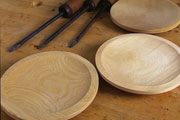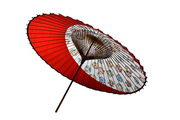Fukushima and more
- Sort by
- Popularity
- Name
-
Shigaraki ware Shigaraki yaki
- Ceramic
- Shiga

Shigaraki ware (called Shigaraki yaki in Japanese) is a type of pottery made around the town of Shigaraki in Shiga prefecture. Clays such as kibushi, mizuchi, or gairome are kneaded to make a strong clay that can be used to make thick and large p…
View more
-
Mino ware Mino yaki
- Ceramic
- Gifu

Mino ware (called Mino yaki in Japanese) is a ceramic ware produced in the Tono area of Gifu prefecture. It has a long history and tradition but has adapted to modern life style. A notable feature of Mino ware is its wide variety of pottery. Mino …
View more
-
Mino traditional Japanese paper Mino washi
- Traditional Japanese paper
- Gifu

Mino washi is a type of Japanese paper made in Gifu prefecture. Washi is made from paper mulberry which is a plant that grows in the city of Mino, a place of abundant forests. Ancient manuscripts in the Shosoin Repository* indicate the history of …
View more
-
Aizu lacquerware Aizu nuri
- Lacquerware
- Fukushima

Aizu lacquerware (called Aizu nuri in Japanese) is lacquerware made in the Aizu region of Fukushima prefecture. During the manufacturing process, the craft is classified into round pieces, such as bowls, and flat pieces such as trays or stationery…
View more
-
Kiso lacquerware Kiso shikki
- Lacquerware
- Nagano

Kiso lacquerware (called Kiso shikki in Japanese) is produced in Kiso district, now the city of Shiojiri, Nagano prefecture. The area where this craft is produced is a plateau approximately 900 meters above sea level. The climate has cool summers…
View more
-
Matsumoto furniture Matsumoto kagu
- Wood, bamboo crafts
- Nagano

Matsumoto kagu is a type of Japanese traditional furniture made in the city of Matsumoto in Nagano prefecture and has been produced for over three hundred years, since the Edo period (1603-1868). The Second World War led production of this craft t…
View more
-
Obori-soma ware Obori soma yaki
- Ceramic
- Fukushima

Obori-soma ware (called Obori-soma yaki in Japanese) is a form of porcelain produced around the town of Namie in Fukushima prefecture. This craft uses blue porcelain enamel which is made from locally collected grindstone. The distinctive feature …
View more
-
Aizu-hongo ware Aizu hongo yaki
- Ceramic
- Fukushima

Aizu-hongo ware (called Aizu-hongo yaki in Japanese) is a traditional handicraft from the region of Aizu in Fukushima prefecture with a history of about four hundred years. This pottery, which is thought to have originated during the Sengoku perio…
View more
-
Gifu lanterns Gifu chochin
- Other crafts
- Gifu

Gifu lanterns (called Gifu chochin in Japanese) are produced in the city of Gifu, Gifu prefecture and have a history of over three hundred years. In 1995, their high level of craftsmanship was recognized with a designation as a National Traditiona…
View more
-
Shodai ware Shodai yaki
- Ceramic
- Kumamoto

Shodai ware (called Shodai yaki in Japanese) is a form of pottery baked mainly in the northern part of Kumamoto prefecture. This craft is distinguishable because of its simple texture, strong form, and bold design, which is due to the pouring meth…
View more
-
Yamaga lanterns Yamaga toro
- Other crafts
- Kumamoto

Yamaga toro are lanterns made of washi (traditional Japanese paper) produced in the area surrounding the city of Yamaga, Kumamoto prefecture. For the Yamaga Lantern Festival, an annual summer event, this craft is worn by one thousand dancing women…
View more
-
Ichii woodcarvings Ichii itto bori
- Wood, bamboo crafts
- Gifu

Ichii woodcarvings (called Ichii itto bori in Japanese) are produced in the Hida region of Gifu prefecture, and made only from the wood of ichii (Japanese yew), the prefectural tree of Gifu. The ichii tree gets its name from a scepter made of Japa…
View more
-
Omi ramie cloth Omi jofu
- Woven textiles
- Shiga

Omi jofu is a textile produced in the region surrounding the town of Koto in Shiga prefecture. It is made with handwoven ramie threads. This craft has chic kasuri* or ikat patterns and a refreshing texture from being woven with fine ramie threads.…
View more
-
Suruga bamboo crafts Suruga takesensuji zaiku
- Wood, bamboo crafts
- Shizuoka

Suruga bamboo ware (called Suruga take sensuji zaiku in Japanese) is produced in the city of Shizuoka, Shizuoka prefecture. High quality bamboo has grown wild in the basin of the upper reaches of the Abe River in Shizuoka since ancient times. Bamb…
View more
-
Hida-shunkei lacquerware Hida shunkei
- Lacquerware
- Gifu

Hida-shunkei lacquerware is produced around the city of Takayama in Gifu prefecture. The name is said to come from the fact that the articles produced initially had a similar coloring to Hishunkei tea containers. This craft is notable for having …
View more
-
Kishu lacquerware Kishu shikki
- Lacquerware
- Wakayama

Kishu lacquerware, also known as kuroe-nuri, is produced around the Kuro-e region northwest of the city of Kainan, Wakayama prefecture. This craft is simple, durable, and practical and has been popular as a household good since the Edo period (160…
View more
-
Kishu bamboo fishing rods Kishu herazao
- Wood, bamboo crafts
- Wakayama

Kishu bamboo fishing rods (called Kishu herazao in Japanese) are produced in the city of Hashimoto, Wakayama prefecture for catching Japanese crucian carp. The bamboos: suzutake, madake, and yadake are cut, left to dry for several years, and only …
View more
-
Shinshu tsumugi silk Shinshu tsumugi
- Woven textiles
- Nagano

Shinshu tsumugi is a type of silk fabric also known as pongee and produced throughout Nagano prefecture. Each region in the prefecture has their own production styles and techniques. Also, the specific name of this fabric differs depending on the …
View more
-
Amakusa ceramics Amakusa tojiki
- Ceramic
- Kumamoto

Amakusa ware (called Amakusa Tojiki in Japanese) is a form of pottery or porcelain baked in the Amakusa region of Kumamoto prefecture. The name was newly applied when the craft was designated as a national traditional craft. In Amakusa, where high…
View more
-
Hikone Buddhist altar Hikone butsudan
- Household Buddhist altars
- Shiga

Hikone Buddhist Altars (called Hikone Butsudan in Japanese) are produced in the city of Hikone, Shiga prefecture. Using luxurious materials in altar bodies which are usually larger than 121.2 cm, this craft is synonymous with high-grade Buddhist a…
View more
-
Iiyama Buddhist altar Iiyama butsudan
- Household Buddhist altars
- Nagano

Iiyama Buddhist Altars, called Iiyama Butsudan in Japanese, are made around the city of Iiyama, Nagano prefecture. Iiyama is known for its people being devout to Buddhism since ancient times, which sustains the tradition of altar production. This …
View more
-
Uchiyama Japanese paper Uchiyama gami
- Traditional Japanese paper
- Nagano

Uchiyama Gami is a type of traditional Japanese paper made in the Oku-shinano region of northern Nagano prefecture. As a region that gets heavy snowfall during the winter, papermaking production developed to provide supplementary income. This craf…
View more
-
Okuaizu Basketry Oku aizu amikumi zaiku
- Wood, bamboo crafts
- Fukushima

Okuaizu Basketry, called Okuaizu Amikumi Zaiku in Japanese, is basketry produced around Mishima Town, Onuma County, Fukushima Prefecture. As this mountainous area in the Okuaizu region has much snow and farmers are unable to work in the fields in …
View more
-
Shinshu Forged Blades Shinshu uchihamono
- Metal works
- Nagano

Shinshu Forged Blades or Shinshu Uchihamono in Japanese, are metalworks produced around Nagano, Nagano prefecture. As this area was formerly a province called Shinano which was also called Shinshu, these blades are known under the name of "Sh…
View more
-
Higo inlays Higo zogan
- Metal works
- Kumamoto

Higo Zogan is inlaid metal work produced in Kumamoto, Kumamoto prefecture. This craft was formerly used to adorn the gun barrels or sword guards of samurai. Today, however, the skills are used to make personal accessories or interior ornaments. Th…
View more
-
Nagiso woodturning Nagiso rokuro zaiku
- Wood, bamboo crafts
- Nagano

Nagiso Rokuro Zaiku are completely handmade woodwork items made in the area around Nagiso Town, Kiso-gun, Nagano Prefecture. This traditional craft originated in the first half of the 18th century and is known for a special skilled manufacturing c…
View more
-
Suruga-hina doll Suruga hina ningyo
- Dolls, kokeshi
- Shizuoka

Suruga Hina Dolls are dolls made in and around Shizuoka City in Shizuoka. Suruga Hina Dolls are larger than other dolls as thick rice straw is used to form the body which is the center of the doll. It is said that rice straw was used because Shizu…
View more
-
Kishu traditional chest Kishu tansu
- Wood, bamboo crafts
- Wakayama

Kishu Tansu are masterpieces of traditional woodwork made in an area around Wakayama City, Wakayama Prefecture. Kishu Tansu are so called because the manufacturing technique was established in Kishu, the current Wakayama Prefecture. As high-qualit…
View more
-
Suruga doll accessories Suruga hinagu
- Dolls, kokeshi
- Shizuoka

Suruga Hinagu (Hina Doll accessories) are a traditional craft produced mainly in Shizuoka city, Kakegawa city and Yaizu city in Shizuoka prefecture. A distinctive feature of Suruga Hinagu is that every piece of furniture, such as chests of drawers…
View more
-
Gifu Japanese Umbrellas Gifu Wagasa
- Other crafts
- Gifu

Japanese umbrellas are not only used on rainy days or as parasols, but there are also umbrellas used for dancing and larger parasols called nodategasa used for outdoor tea ceremonies. They become very slim and delicate when they are closed, and t…
View more































































































































































































































































































